Yongqiang Zhang
You Only Evaluate Once: A Tree-based Rerank Method at Meituan
Aug 20, 2025



Abstract:Reranking plays a crucial role in modern recommender systems by capturing the mutual influences within the list. Due to the inherent challenges of combinatorial search spaces, most methods adopt a two-stage search paradigm: a simple General Search Unit (GSU) efficiently reduces the candidate space, and an Exact Search Unit (ESU) effectively selects the optimal sequence. These methods essentially involve making trade-offs between effectiveness and efficiency, while suffering from a severe \textbf{inconsistency problem}, that is, the GSU often misses high-value lists from ESU. To address this problem, we propose YOLOR, a one-stage reranking method that removes the GSU while retaining only the ESU. Specifically, YOLOR includes: (1) a Tree-based Context Extraction Module (TCEM) that hierarchically aggregates multi-scale contextual features to achieve "list-level effectiveness", and (2) a Context Cache Module (CCM) that enables efficient feature reuse across candidate permutations to achieve "permutation-level efficiency". Extensive experiments across public and industry datasets validate YOLOR's performance, and we have successfully deployed YOLOR on the Meituan food delivery platform.
Geo-ConvGRU: Geographically Masked Convolutional Gated Recurrent Unit for Bird-Eye View Segmentation
Dec 28, 2024Abstract:Convolutional Neural Networks (CNNs) have significantly impacted various computer vision tasks, however, they inherently struggle to model long-range dependencies explicitly due to the localized nature of convolution operations. Although Transformers have addressed limitations in long-range dependencies for the spatial dimension, the temporal dimension remains underexplored. In this paper, we first highlight that 3D CNNs exhibit limitations in capturing long-range temporal dependencies. Though Transformers mitigate spatial dimension issues, they result in a considerable increase in parameter and processing speed reduction. To overcome these challenges, we introduce a simple yet effective module, Geographically Masked Convolutional Gated Recurrent Unit (Geo-ConvGRU), tailored for Bird's-Eye View segmentation. Specifically, we substitute the 3D CNN layers with ConvGRU in the temporal module to bolster the capacity of networks for handling temporal dependencies. Additionally, we integrate a geographical mask into the Convolutional Gated Recurrent Unit to suppress noise introduced by the temporal module. Comprehensive experiments conducted on the NuScenes dataset substantiate the merits of the proposed Geo-ConvGRU, revealing that our approach attains state-of-the-art performance in Bird's-Eye View segmentation.
Multi-Modality Driven LoRA for Adverse Condition Depth Estimation
Dec 28, 2024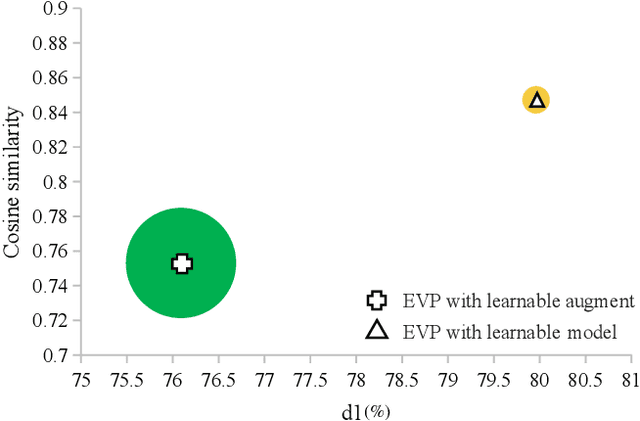
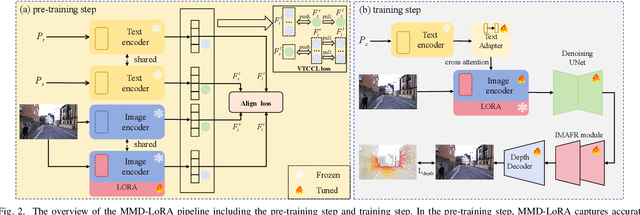
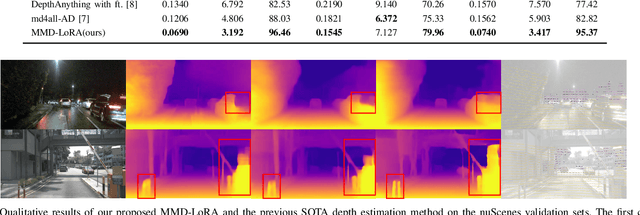

Abstract:The autonomous driving community is increasingly focused on addressing corner case problems, particularly those related to ensuring driving safety under adverse conditions (e.g., nighttime, fog, rain). To this end, the task of Adverse Condition Depth Estimation (ACDE) has gained significant attention. Previous approaches in ACDE have primarily relied on generative models, which necessitate additional target images to convert the sunny condition into adverse weather, or learnable parameters for feature augmentation to adapt domain gaps, resulting in increased model complexity and tuning efforts. Furthermore, unlike CLIP-based methods where textual and visual features have been pre-aligned, depth estimation models lack sufficient alignment between multimodal features, hindering coherent understanding under adverse conditions. To address these limitations, we propose Multi-Modality Driven LoRA (MMD-LoRA), which leverages low-rank adaptation matrices for efficient fine-tuning from source-domain to target-domain. It consists of two core components: Prompt Driven Domain Alignment (PDDA) and Visual-Text Consistent Contrastive Learning(VTCCL). During PDDA, the image encoder with MMD-LoRA generates target-domain visual representations, supervised by alignment loss that the source-target difference between language and image should be equal. Meanwhile, VTCCL bridges the gap between textual features from CLIP and visual features from diffusion model, pushing apart different weather representations (vision and text) and bringing together similar ones. Through extensive experiments, the proposed method achieves state-of-the-art performance on the nuScenes and Oxford RobotCar datasets, underscoring robustness and efficiency in adapting to varied adverse environments.
Boosting Long-tailed Object Detection via Step-wise Learning on Smooth-tail Data
May 22, 2023



Abstract:Real-world data tends to follow a long-tailed distribution, where the class imbalance results in dominance of the head classes during training. In this paper, we propose a frustratingly simple but effective step-wise learning framework to gradually enhance the capability of the model in detecting all categories of long-tailed datasets. Specifically, we build smooth-tail data where the long-tailed distribution of categories decays smoothly to correct the bias towards head classes. We pre-train a model on the whole long-tailed data to preserve discriminability between all categories. We then fine-tune the class-agnostic modules of the pre-trained model on the head class dominant replay data to get a head class expert model with improved decision boundaries from all categories. Finally, we train a unified model on the tail class dominant replay data while transferring knowledge from the head class expert model to ensure accurate detection of all categories. Extensive experiments on long-tailed datasets LVIS v0.5 and LVIS v1.0 demonstrate the superior performance of our method, where we can improve the AP with ResNet-50 backbone from 27.0% to 30.3% AP, and especially for the rare categories from 15.5% to 24.9% AP. Our best model using ResNet-101 backbone can achieve 30.7% AP, which suppresses all existing detectors using the same backbone.
NeFII: Inverse Rendering for Reflectance Decomposition with Near-Field Indirect Illumination
Mar 29, 2023



Abstract:Inverse rendering methods aim to estimate geometry, materials and illumination from multi-view RGB images. In order to achieve better decomposition, recent approaches attempt to model indirect illuminations reflected from different materials via Spherical Gaussians (SG), which, however, tends to blur the high-frequency reflection details. In this paper, we propose an end-to-end inverse rendering pipeline that decomposes materials and illumination from multi-view images, while considering near-field indirect illumination. In a nutshell, we introduce the Monte Carlo sampling based path tracing and cache the indirect illumination as neural radiance, enabling a physics-faithful and easy-to-optimize inverse rendering method. To enhance efficiency and practicality, we leverage SG to represent the smooth environment illuminations and apply importance sampling techniques. To supervise indirect illuminations from unobserved directions, we develop a novel radiance consistency constraint between implicit neural radiance and path tracing results of unobserved rays along with the joint optimization of materials and illuminations, thus significantly improving the decomposition performance. Extensive experiments demonstrate that our method outperforms the state-of-the-art on multiple synthetic and real datasets, especially in terms of inter-reflection decomposition.
Open World DETR: Transformer based Open World Object Detection
Dec 06, 2022



Abstract:Open world object detection aims at detecting objects that are absent in the object classes of the training data as unknown objects without explicit supervision. Furthermore, the exact classes of the unknown objects must be identified without catastrophic forgetting of the previous known classes when the corresponding annotations of unknown objects are given incrementally. In this paper, we propose a two-stage training approach named Open World DETR for open world object detection based on Deformable DETR. In the first stage, we pre-train a model on the current annotated data to detect objects from the current known classes, and concurrently train an additional binary classifier to classify predictions into foreground or background classes. This helps the model to build an unbiased feature representations that can facilitate the detection of unknown classes in subsequent process. In the second stage, we fine-tune the class-specific components of the model with a multi-view self-labeling strategy and a consistency constraint. Furthermore, we alleviate catastrophic forgetting when the annotations of the unknown classes becomes available incrementally by using knowledge distillation and exemplar replay. Experimental results on PASCAL VOC and MS-COCO show that our proposed method outperforms other state-of-the-art open world object detection methods by a large margin.
Incremental-DETR: Incremental Few-Shot Object Detection via Self-Supervised Learning
May 19, 2022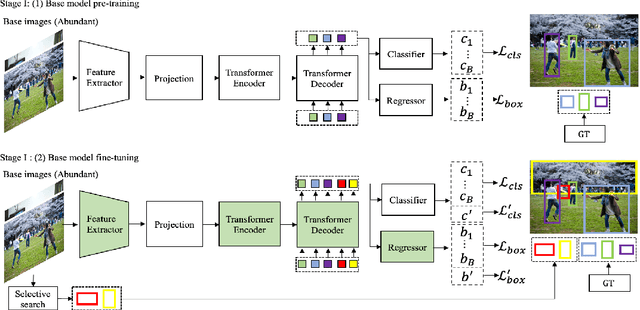

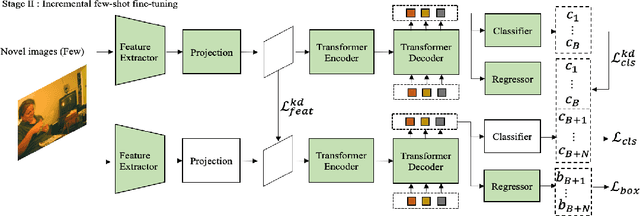

Abstract:Incremental few-shot object detection aims at detecting novel classes without forgetting knowledge of the base classes with only a few labeled training data from the novel classes. Most related prior works are on incremental object detection that rely on the availability of abundant training samples per novel class that substantially limits the scalability to real-world setting where novel data can be scarce. In this paper, we propose the Incremental-DETR that does incremental few-shot object detection via fine-tuning and self-supervised learning on the DETR object detector. To alleviate severe over-fitting with few novel class data, we first fine-tune the class-specific components of DETR with self-supervision from additional object proposals generated using Selective Search as pseudo labels. We further introduce a incremental few-shot fine-tuning strategy with knowledge distillation on the class-specific components of DETR to encourage the network in detecting novel classes without catastrophic forgetting. Extensive experiments conducted on standard incremental object detection and incremental few-shot object detection settings show that our approach significantly outperforms state-of-the-art methods by a large margin.
Bridging Non Co-occurrence with Unlabeled In-the-wild Data for Incremental Object Detection
Oct 28, 2021
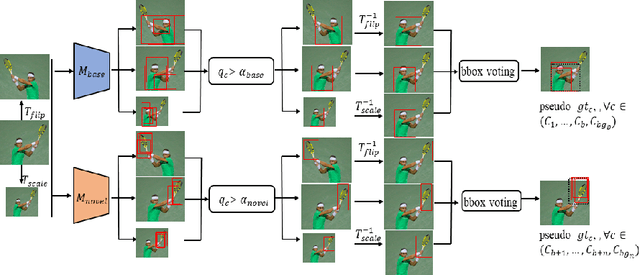
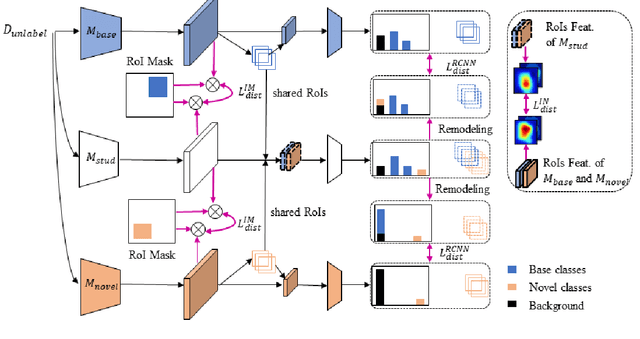
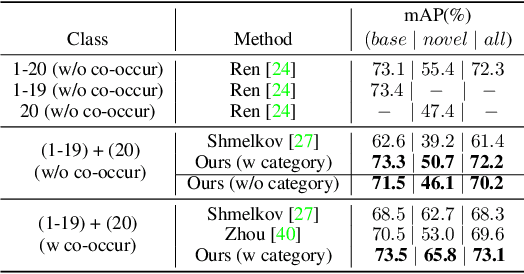
Abstract:Deep networks have shown remarkable results in the task of object detection. However, their performance suffers critical drops when they are subsequently trained on novel classes without any sample from the base classes originally used to train the model. This phenomenon is known as catastrophic forgetting. Recently, several incremental learning methods are proposed to mitigate catastrophic forgetting for object detection. Despite the effectiveness, these methods require co-occurrence of the unlabeled base classes in the training data of the novel classes. This requirement is impractical in many real-world settings since the base classes do not necessarily co-occur with the novel classes. In view of this limitation, we consider a more practical setting of complete absence of co-occurrence of the base and novel classes for the object detection task. We propose the use of unlabeled in-the-wild data to bridge the non co-occurrence caused by the missing base classes during the training of additional novel classes. To this end, we introduce a blind sampling strategy based on the responses of the base-class model and pre-trained novel-class model to select a smaller relevant dataset from the large in-the-wild dataset for incremental learning. We then design a dual-teacher distillation framework to transfer the knowledge distilled from the base- and novel-class teacher models to the student model using the sampled in-the-wild data. Experimental results on the PASCAL VOC and MS COCO datasets show that our proposed method significantly outperforms other state-of-the-art class-incremental object detection methods when there is no co-occurrence between the base and novel classes during training.
A Survey on Integrated Access and Backhaul Networks
Jan 04, 2021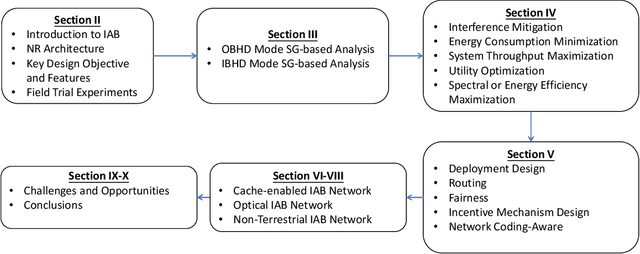
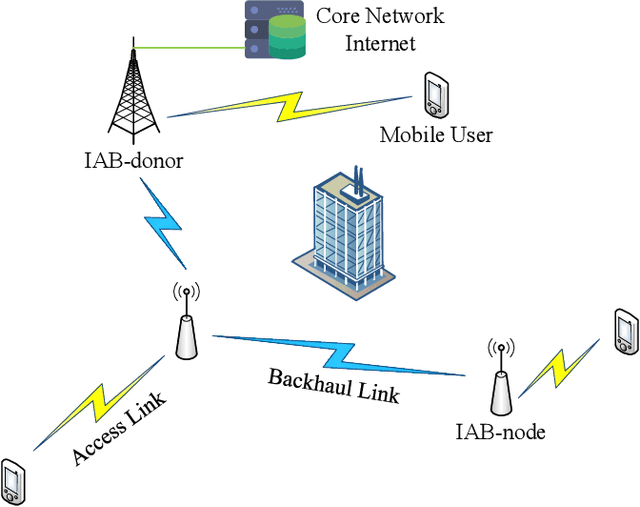
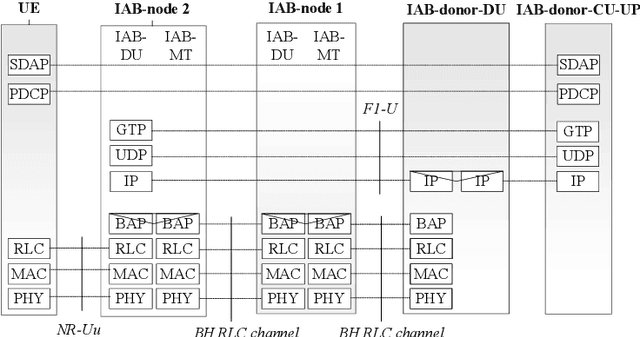
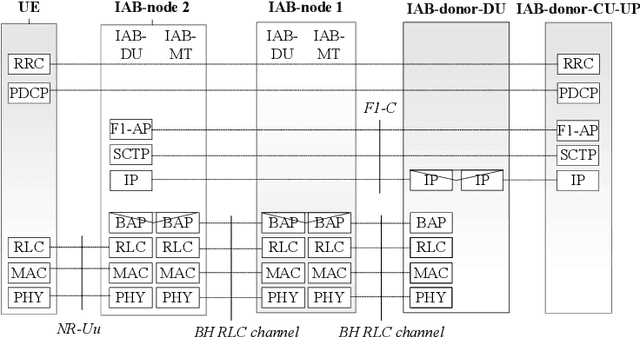
Abstract:Benefiting from the usage of the high-frequency band, utilizing part of the large available bandwidth for wireless backhauling is feasible without considerable performance sacrifice. In this context, integrated access and backhaul (IAB) was proposed by 3GPP to reduce the fiber optics deployment cost of 5G and beyond networks. In this paper, we first give a brief introduction of IAB based on the 3GPP release. After that, we survey existing research on IAB networks, the integrations of IAB to cache-enabled network, optical communication transport network, and the non-terrestrial network. Finally, we discuss the challenges and opportunities that might arise while developing and commercializing IAB networks.
 Add to Chrome
Add to Chrome Add to Firefox
Add to Firefox Add to Edge
Add to Edge